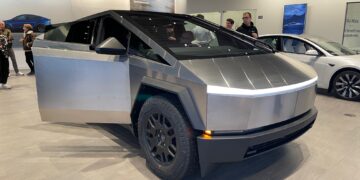Car shows have become a shadow of their former selves over the last few years. Only a few new cars are launched at the events in Europe and America, compared to the focus these exhibitions used to have in previous decades. But one country still flies the flag for automotive event excitement: China. Its biggest show, Auto China, alternates between Shanghai and Beijing, and we got to go to this year’s huge festival of vehicles, hosted by the latter city.
The first thing to underline about the Auto China is that it’s gobsmackingly massive. There are four huge halls, booths outside the halls, and a few things going on at other locations around the city as well. There are launches going on left, right and centre. Unlike the IAA Munich show we attended last year, where the BMW Neue Klasse as well as the updates to the electric Minis were unveiled offsite, a lot of activity takes place within the exhibition centre itself in China. In fact, 117 new models were unveiled this year, compared to 93 last year in Shanghai, with 278 “new energy vehicles” on display.

As you wander around the halls, a sense of being overwhelmed grabs you. This is particularly true if you can’t read or speak Chinese. There are many brands that are unheard of outside China, and many you will have heard of but might not immediately recognise. Nio, for example, didn’t appear to have the word “Nio” visible anywhere on its stand. It was probably there as a Chinese character and the logo was recognisable, as were the model names. Many of these can now be purchased in the EU, although Nio hasn’t come to the UK yet. But we had to take a closer look to confirm this was Nio.

Some brands were completely unrecognisable. Or they might have been familiar and didn’t include the anglicised version of their name on the display. But there were plenty of familiar companies on show too. MG had the Cyberster in all its glory, alongside the MG4 and a concept car. The Cyberster is imminent in the UK, with prices announced and the order book open. There was also the MG7, which is a great-looking car with some of the Cyberster’s styling at the front but sadly petrol only, with not even a hybrid version. Some of SAIC’s (owner of MG) other brands were nearby, including Roewe. The MG5 is actually a Roewe vehicle rebadged in Europe as MG. It’s a very popular car amongst taxi drivers in China, too. SAIC also owns Maxus, a name that you may have seen on electric vans in the UK. It also has an electric pickup in the British market. But in China it has other vehicles available, including a camper van.

Rolls Royce’s electric Spectre was on show, in a particularly garish salmon pink with grey bonnet and roof. Lamborghini had a couple of plug-in hybrids on its stand: the Urus SE, an 800hp SUV that was launched at Auto China, and the Revuelto, a 1,001hp hypercar that can accelerate to 62mph in just 2.5 second and has a top speed of 217mph. Mercedes launched its electric G-wagon, the G580 with EQ Technology.

There has been a lot of attention given to Xiaomi’s entry into the car business with its SU7. Some reckon this car has Porsche vibes, or at least as seen through the lens of the Hyundai Ioniq 6. Incredibly, Xiaomi (yes, that’s the phone manufacturer) has 75,000 orders already for the SU7, 50,000 of them in the first 27 minutes of going on sale, and has built 10,000 units in the first 32 days after launch. This is another incredibly technology-packed vehicle, and at the time of writing 5,781 units had been delivered to customers in China, although there are hints of expansion to other markets.
Smart is clearly reinventing itself as a rather different company to the one we’ve known for a couple of decades as a producer of tiny urban vehicles. The company is now a joint venture between Chinese Geely and Mercedes-Benz. The Smart #1 was just the beginning of the company’ shift to larger, more mainstream vehicles, and has been followed by the even bigger #3. At Auto China, Smart unveiled the Concept #5, an offroad-capable SUV with a battery larger than 100kWh and over 340 miles of range, slated for production version release in the second half of 2024.

BYD had a massive stand, unsurprisingly, to show off its burgeoning range of EVs. The big BYD release, as we reported, was the Ocean-M. It’s intended as a direct competitor to the MG4, although technical specifications are still thin on the ground. Another company showing off a concept that isn’t in production yet was Zeekr with its Mix MPV. Like the Ocean-M, this car will arrive soon. It addresses a different need in the Chinese market – vehicles aimed at families that are now more affluent and looking at leisure time. Its double sliding doors and rotating seats make the Mix both a place for a family to hang out in at a destination as well as the vehicle they use to get there in the first place. Zeekr also plans capable autonomous driving for the Mix, which has more than a passing resemblance to the “robotaxi” Zeekr produced for Waymo a few years ago.

The Chinese market is starting to lead the world, and its massive size means its importance is only set to grow. Volkswagen has announced a new electric sub-brand for China called the ID Code, alongside another sub-brand called ID.UX aimed at younger customers. Apparently, the first vehicle from ID.UX will be called the Unyx (hopefully not operated with command lines only).
One theme at the show was the prevalence of PHEVs. For example, Chery is a brand we might not know well in the UK, although it’s actually the parent company of Omoda, which recently launched its 5 EV here. Rather than announcing new BEVs, Chery’s big launch during our visit was the Tiggo 9 PHEV. This will particularly target South Africa, known as the Chery Fulwin T9 in that market, and illustrates the realisation that some countries won’t be ready for widespread adoption of BEVs for some years to come.
Other titbits at Auto China 2024 included Nissan concept cars and Kia’s EV5 (a small SUV cousin to the EV9). Outside the event, we got to try Geely’s Geome Panda (formerly the Geometry Panda Mini EV), a tiny EV with a 40hp motor and range up to 200km. It has four usable seats and even a reversing camera. But, crucially, the Panda costs around 50,000 RMB (£5,500), making it unbelievable value. On the other end of the scale, Geely’s Farizon truck brand launched an electric version called Homtruck, which has 400km of electric range and can incorporate a methanol-powered range extender engine for 1,400km of range. Its cab includes a bed, cooker, fridge, toilet, and shower for the driver who never wants to leave the road.
The impression you get if you walk around with an open mind is that Chinese cars are no longer wannabe copies of European, American, and Japanese designs. There are a few that still pay homage, and there is quite a lot of similarity between cars from different Chinese brands. But the designs feel much more original, with some being exceptionally cool. The MG Cyberster is beautiful, and Xiaomi’s SU7 is a looker too, which is incredible for a phone company that wasn’t even in the car business until 2021. If you thought China was playing catchup in the auto industry, think again. Auto China 2024 shows that Western automakers might be the ones playing catchup soon.




































Discussion about this post